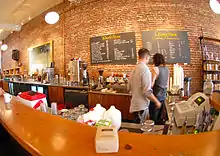Coffee in Portland, Oregon
Portland, Oregon, in the United States, is known for having an established coffee culture. In February 2012, The New York Times reported that Portland had more than 30 coffee roasters. Comparing Portland's coffee culture to other major cities along the West Coast, Oliver Strand wrote: "Seattle coffee might have more muscle, and San Francisco coffee might have more mystique, but Portland's coffee scene is arguably the country's most intimate. It's also one of the most relaxed."[1]

Coffeehouses and roasters
Coffeehouses have included Coffee Time, Rimsky-Korsakoffee House, and Southeast Grind (2009–2019).
Some of Portland's roasters include Coava Coffee Roasters, Heart Coffee Roasters, Water Avenue Coffee, Sterling Coffee Roasters and Stumptown Coffee Roasters.[1]
Events
In 2012, the Specialty Coffee Association of America hosted its annual convention, billed as "the largest coffee industry gathering in the world", at the Oregon Convention Center.[2]
Prevalence
Portland is noted as a place in which people use coffeehouses as a third place.[3] There is more coffee available in gentrified areas of Portland.[4]
See also
References
- Strand, Oliver (February 10, 2012). "In Portland, Ore., a D.I.Y. Coffee Culture". The New York Times. The New York Times Company. Retrieved February 3, 2014. Note: A version of this article appeared in print on February 12, 2012, on page TR4 of the New York edition with the headline: "Portland's Purist Coffee Scene".
- House, Kelly (April 13, 2012). "Portland abuzz over hosting coffee's biggest event". The Oregonian. Retrieved February 3, 2014.
- Salvador, T.; Sherry, J. W.; Urrutia, A. E. (2005). "Less cyber, more café: Enhancing existing small businesses across the digital divide with ICTs". Information Technology for Development. 11: 77. doi:10.1002/itdj.20004.
- Monroe Sullivan, D.; Shaw, S. C. (2011). "Retail Gentrification and Race: The Case of Alberta Street in Portland, Oregon". Urban Affairs Review. 47 (3): 413. doi:10.1177/1078087410393472.
Further reading
- Bauer, Kathleen (February 2009). "The New Portland Coffee Micro Roasters". OregonLive.com. Retrieved 3 February 2014.
- Brown, Ruth (21 November 2012). "Coffee Issue 2012: Portland's best new coffee shops and trends". Willamette Week. Retrieved 3 February 2014.
External links
- Here is a List of Every Coffee Roaster in Portland (We Think), Willamette Week (2012)
- 10 things to consider when going off the grid Sprudge, a Portland coffee blog